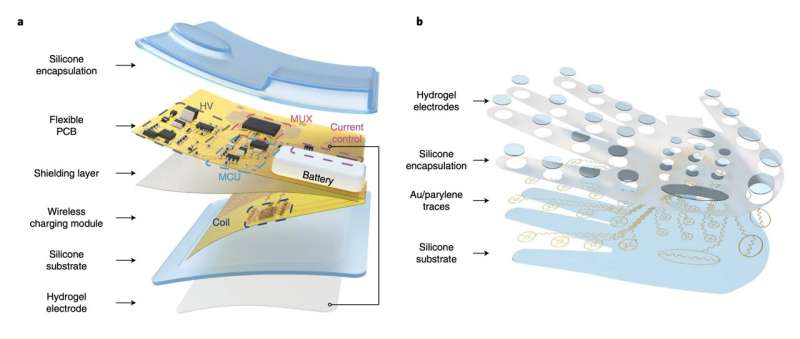November 4, 2022 feature
WeTac: A small, soft and ultrathin wireless electrotactile system

Virtual reality (VR) and augmented reality (AR) headsets are becoming increasingly advanced, enabling increasingly engaging and immersive digital experiences. To make VR and AR experiences even more realistic, engineers have been trying to create better systems that produce tactile and haptic feedback matching virtual content.
Researchers at University of Hong Kong, City University of Hong Kong, University of Electronic Science and Technology of China (UESTC) and other institutes in China have recently created WeTac, a miniaturized, soft and ultrathin wireless electrotactile system that produces tactile sensations on a user's skin. This system, introduced in Nature Machine Intelligence, works by delivering electrical current through a user's hand.
"As the tactile sensitivity among different individuals and different parts of the hand within a person varies widely, a universal method to encode tactile information into faithful feedback in hands according to sensitivity features is urgently needed," Kuanming Yao and his colleagues wrote in their paper. "In addition, existing haptic interfaces worn on the hand are usually bulky, rigid and tethered by cables, which is a hurdle for accurately and naturally providing haptic feedback."
WeTac consists of a series of electrodes, which are placed over a user's palm, and miniaturized soft electronic components that act as the device's control panel. When worn by users, the device can produce detailed and programmable spatio-temporal haptic feedback patterns, with 32 electrotactile simulation pixels on the side of the palm and high spatial resolution of 0.279 pixels per cm2 in the densest region.
"WeTac delivers current through the hand to induce tactile sensations as the skin-integrated haptic interface," the researchers wrote in their paper. "With a relatively high pixel density over the whole hand area, the WeTac can provide tactile stimulation and measure the sensation thresholds of users in a flexible way."
The device create by Yao and his colleagues has notable advantages over other electrotactile devices developed in the past. Most notably, it covers a wider surface of a user's hand (i.e., the whole hand), rather than focusing on one or more fingertips.
In addition, as its component are ultrasoft, WeTac can easily map threshold currents for individual users, identifying optimal parameters for producing haptic feedback in specific parts of the hand. This could lead to full-hand, realistic, and personalized tactile experiences that can be clearly felt by users, without causing them pain.
"By mapping the thresholds for different electrical parameters, personalized threshold data can be acquired to reproduce virtual touching sensations on the hand with optimized stimulation intensity and avoid causing pain," the researchers explained in their paper. "With an accurate control of sensation level, temporal and spatial perception, it allows providing personalized feedback when users interact with virtual objects."
In initial tests, the wireless electrotactile device created by the researchers achieved very promising results, producing vivid and adjustable haptic feedback on users' hands. In the future, it could be integrated with VR and AR systems, to create more vivid and engaging virtual experiences or to enhance human-machine interactions.
More information: Kuanming Yao et al, Encoding of tactile information in hand via skin-integrated wireless haptic interface, Nature Machine Intelligence (2022). DOI: 10.1038/s42256-022-00543-y
© 2022 Science X Network




















